When the sun goes down, some animals go into hiding. But for nocturnal creatures, their night has just begun. This is the time for these animals to go out and search for food.
During this period, night predators are also lurking around the corner, waiting patiently to hunt and strike their prey.
But there is nothing more dangerous for small terrestrial animals at night other than aerial predators such as owls.
Owls are one of the night bird species that possess exceptional senses and agility. Although they are voracious hunters, these birds are physically unique and appealing in their own way. In fact, we can strongly agree that out of all types of owls, barn owls are the cutest owls we can find out there.
But how many types of barn owls exist in this world? Fret not, we have listed 15 types of barn owls that will surely catch your attention.
Table of Contents
1. Western Barn Owl (Tyto alba)

Western barn owls are found in many countries including Europe, southern and central Asia, Africa, and North America. However, there’s no sighting of these birds in Antarctica.
The owls also go by many other names such as ghost owls, common barn owls, monkey-faced owls, and church owls.
Western barn owls measure 13 to 16 inches long and weigh 15 to 22 ounces. Their wings can extend up to 43 inches wide.
These medium-sized birds possess heart-shaped, white faces, dark brown eyes, light brown to pale pink beaks, grayish-brown bodies, light brown crowns, and whitish-gray underparts.
On average, western barn owls only live up to 2 years. In some cases, healthy wild owls that live in a favorable environment can survive up to 34 years.
These birds prey on different types of small animals such as rats, lizards, frogs, young rabbits, bats, shrews, mice, and even insects.
2. Eastern Barn Owl (Tyto javanica)

Eastern barn owls are indigenous to Southeast Asia, Australasia, the Indonesian archipelago, and other small islands in the Pacific Ocean.
They usually spend most of their time in open forests, farms, grassland, and villages.
You can spot eastern barn owls by their heart-shaped, white faces, dark brown eyes, brownish-yellow to pale orange crowns and backs, whitish-cream underparts, and pink bills.
These birds measure 12 to 14 inches long and weigh 8 to 17 ounces.
Eastern barn owls are solitary hunters and perch on tree branches or hollow logs, before striking their prey.
These birds generally consume birds, small mammals, insects, mice, rodents, and small reptiles. Since they don’t produce noisy flapping sounds, eastern barn owls can easily sneak up on and catch their food.
These owls also nest in hollow tree cavities, abandoned buildings, or caves. They produce 3 to 6 pale white eggs per clutch.
3. American Barn Owl (Tyto furcata)
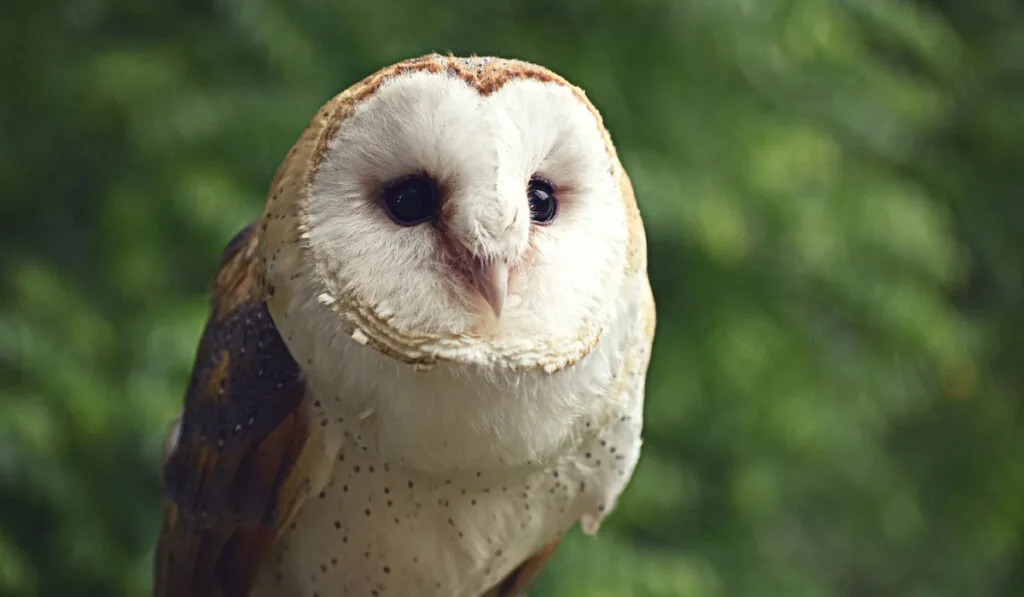
Like their name, American barn owls or North American barn owls are native to the Americas, particularly in the south and central regions. They are widely distributed in many tropical and subtropical forests.
American barn owls have white faces with brownish-orange rims, dark brown eyes, brownish-yellow crowns and backs with random pale gray spots, and whitish-cream bills.
On average, they measure 13 to 15 inches long and weigh 14 to 23 ounces. These owls can also spread their wings up to 14 inches wide.
Since American barn owls feed on rodents and mice, they are used by farmers in the United States to control those pests from destroying plants and other crops.
This practice is usually done by building or placing nestboxes that act as safe spaces for these birds to live and breed in.
4. Andaman Masked Owl (Tyto deroepstorffi)

Andaman masked owls are found exclusively in the Andaman Islands which are located in the northeastern Indian Ocean.
These birds generally inhabit coastal areas, open fields with vegetation, and forest edges.
You can recognize this species by their whitish to buff red faces, brownish-black eyes, whitish-cream bills, reddish-brown crowns and backs, and brownish-golden chests and underparts filled with small dark spots.
These birds measure 12 to 14 inches long with wings that spread up to 10 inches wide. They usually stay in their native habitats and rarely migrate.
Andaman masked owls prey on mice and rodents. Researchers have also found some remains of their prey’s bones scattered underneath their roosting places.
5. Manus Masked Owl (Tyto manusi)
Manus masked owls are native to Manus Island located in northern Papua New Guinea.
These endemic species possess heart-shaped, buff to brown faces with dark-colored ridges, dark eyes, brownish-black crowns and backs, and buff underparts filled with small dark spots.
Records indicate that the population of Manus masked owls in this world is less than 1,000 individuals.
However, due to the lack of findings or sightings of this species, there are still many things that remain unknown to the public.
6. Ashy-Faced Owl (Tyto glaucops)
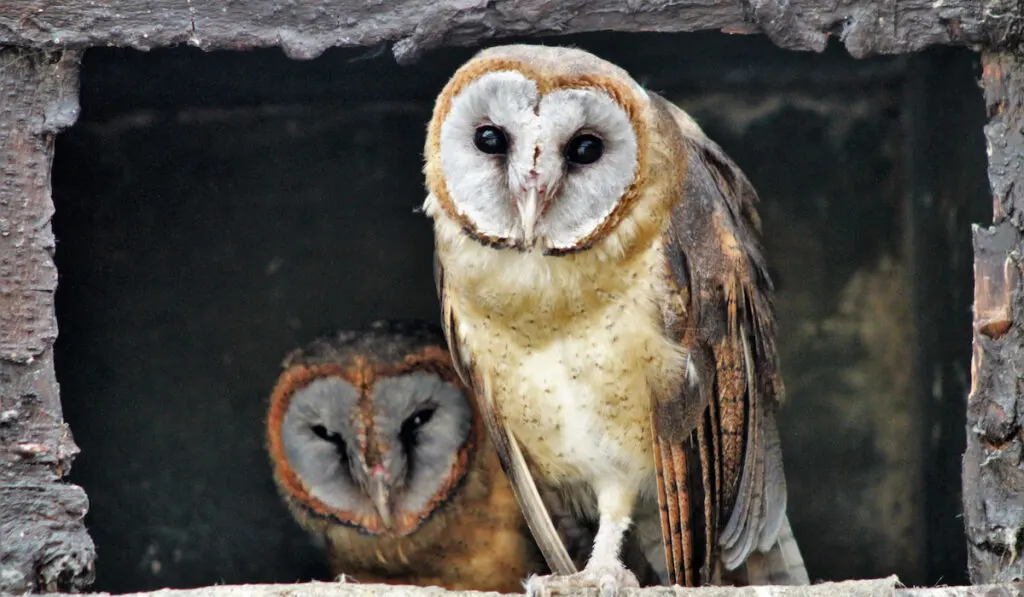
Ashy-faced owls, also called Hispaniolan barn owls, are exclusively found in Hispaniola, the second largest island of the West Indies located in the Caribbean Sea.
These birds generally inhabit agricultural fields, tropical and subtropical woodlands, caves, dry shrublands, and open spaces that are close to villages and housing areas.
Since they don’t migrate, you can only find this species in their native habitats.
As their name states, ashy-faced owls have ash-colored faces, brownish-yellow crowns and backs filled with random dark speckles, and pale underparts. These owls measure 10 to 17 inches long and weigh 7 to 14 ounces.
Ashy-faced owls feed on various small animals including rodents, mice, bats, small reptiles, and several species of small birds.
These birds also indirectly help farmers by controlling the population of rats, thus reducing the number of destroyed crops.
7. Australian Masked Owl (Tyto novaehollandiae)

Australian masked owls are indigenous to Australia and southern parts of New Guinea. Due to their habit of catching rodents and mice, they were once known as mouse owls.
These owls prefer to spend most of their time in pine plantations, swamps, farmland, mangrove areas, and wooded areas filled with growing trees.
They also nest inside large tree holes and other natural cavities.
You can recognize Australian masked owls by their heart-shaped white faces with dark brown ridges, blackish-brown eyes, brown crowns and backs covered with light gray speckles, and white underparts filled with small brown spots.
On average, these owls measure 13 to 20 inches long and weigh 1 to 3 pounds. Females are slightly larger than males. This also gives them the ability to catch larger prey that the males can’t grab.
Australian masked owls feed on many creatures such as rodents, bats, birds, possums, rabbits, insects, bandicoots, and small reptiles.
8. African Grass Owl (Tyto capensis)
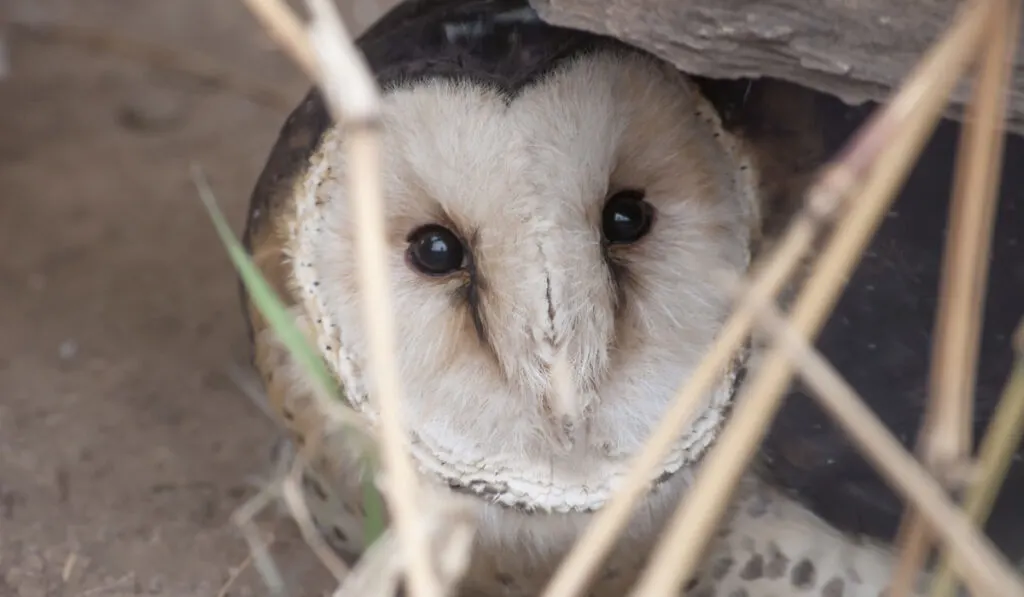
African grass owls are native to sub-Saharan Africa and mountainous regions in Cameroon. They generally inhabit wetlands, marshes, ponds, creeks, and water bodies with tall grasses.
These owls possess heart-shaped white faces with yellow ridges full of dark spots, dark brown to black eyes, whitish-pink beaks, dark brown upperparts, and white to pale-buff underparts filled with small dark spots.
They measure 15 to 17 inches long and weigh 13 to 18 ounces. Their wings can spread up to 14 inches wide.
This owl feeds on rodents, shrews, bats, small birds and mammals, frogs, and other invertebrates.
African grass owls usually nest on the ground, in hidden spots between tall grasses, to avoid detection from predators.
Females usually lay 2 to 4 white eggs per clutch before incubating them for 32 to 42 days. Both parents are responsible for nurturing and taking care of their young.
9. Taliabu Masked Owl (Tyto nigrobunnea)
These exotic and rare owls are exclusively found on Taliabu Island located in North Maluku Province, Indonesia. They are also known as the Sula Islands barn owls.
You can spot these owls by their brownish-red face with dark-colored centers and ridges, blackish-brown eyes, dark gray beaks, dark brown crowns and backs covered with white spots, and brownish-gold underparts covered in small dark spots.
Taliabu masked owls measure 12 inches long with wings that spread up to 11 inches wide.
This species is mostly found near dense forests, bamboo thickets, forest edges, and lowlands.
10. Greater Sooty Owl (Tyto tenebricosa)
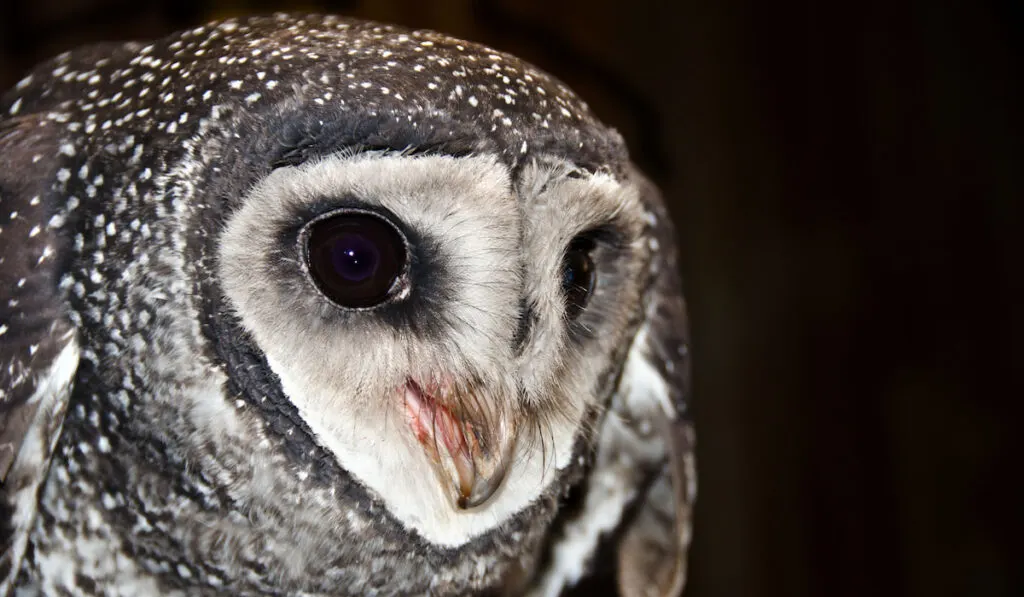
Greater sooty owls are native to southeastern Australia, Indonesia, and the New Guinea islands. They usually inhabit grasslands, eucalyptus forests, and shrublands.
This species prefers to live and breed in moist regions but feeds and hunts in dry areas.
You can recognize greater sooty owls by their distinctive dark, grayish-brown faces, black eyes, white to cream beaks, sooty blackish-brown bodies filled with small white speckles, and light gray underparts.
These medium-sized owls measure 15 to 20 inches long and weigh 18 to 41 ounces. Their wings can spread up to 14 inches wide.
Greater sooty owls feed on various small mammals such as rodents, bandicoots, sugar gliders, and ringtail possums. They also consume insects, bats, and small birds.
When breeding season comes, these birds will nest in large tree cavities or unoccupied caves. Females can lay 1 to 2 pale white eggs before incubating them for 42 days.
11. Minahasa Masked Owl (Tyto inexspectata)
Minahasa masked owls are indigenous to Sulawesi Island in Indonesia. They are also known as Sulawesi golden owls and Minahasa barn owls.
A Minahasa masked owl is a forest-dwelling bird that prefers to live in deep rainforests that have ferns, palms, lianas, and forest edges.
Tree cavities are their favorite spots for breeding and nesting.
Minahasa masked owls possess rusty cream-colored faces with dark brown ridges, pale to white beaks, dark brown eyes, grayish-brown crowns and backs filled with white and black speckles, and pale cream underparts filled with dark spots.
They also have grayish-brown legs and dark brown claws.
On average, these owls measure 11 to 12 inches long with wings that only spread 11 inches wide. Due to their short wings, these species rarely move out of their native habitats.
12. Itombwe Owl (Tyto prigoginei)
Itombwe owls are native to the Albertine Rift montane forests in Uganda. They are also called African bay owls and Congo bay owls.
These mysterious birds were first discovered in 1951 near the Itombwe Mountains, Democratic Republic of Congo.
There were little to no traces of this species for quite some time until they reappeared in 1996 near the southeast region of Itombwe forests.
Itombwe owls have distinctive light brown faces, dark eyes, chestnut-brown crowns and backs, pale red to orange underparts, and white spots scattered all over their crowns.
These physical attributes are only found in females due to the lack of sightings of males and juveniles.
Due to deforestation and habitat destruction, these owls are considered endangered.
13. Moluccan Masked Owl (Tyto sororcula)
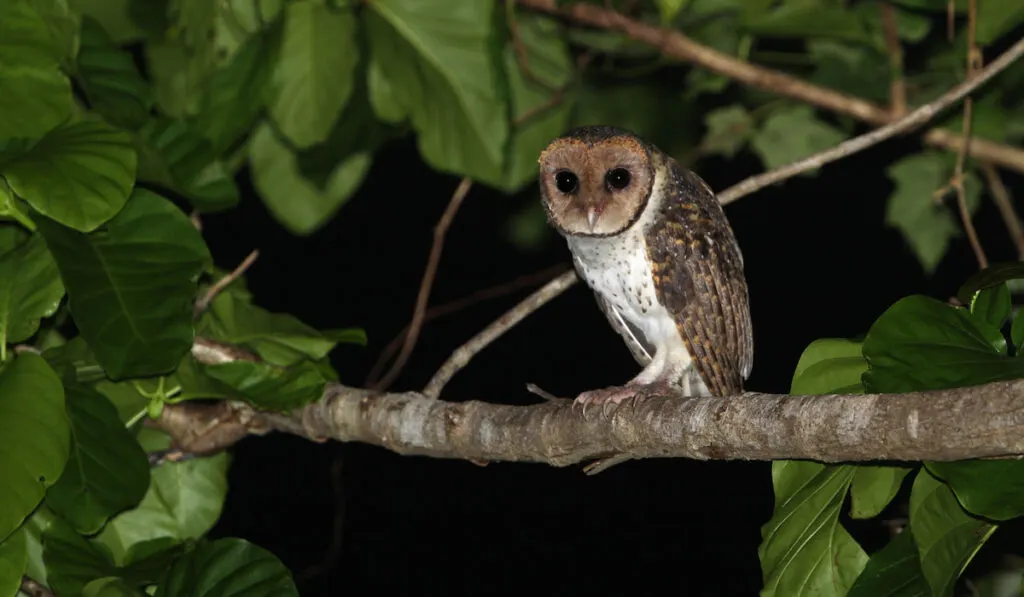
Moluccan masked owls or lesser masked owls are exclusively found in the south Moluccas or Maluku Islands in Indonesia, specifically in Tanimbar and Buru Islands.
They spend most of their time in the forests, lowlands, and foothills, or hide in limestone caves during daylight hours.
You can spot Moluccan masked owls by their pale buff faces with dark brown ridges, dark eyes, creamish-yellow beaks, dark brown crowns and backs filled with white speckles, and pale to buff underparts with dark spots.
These medium-sized owls measure 11 to 12 inches long with wings that can extend up to 10 inches wide.
Since there is not much information available out there on this species, researchers and the public still have a lot to learn about Moluccan masked owls.
14. Sulawesi Masked Owl (Tyto rosenbergii)
Sulawesi masked owls are indigenous to the Sulawesi islands in Indonesia, particularly in Peleng and Sangihe. They generally inhabit grasslands, open cultivated areas, villages, rainforests, and forest edges.
Sulawesi masked owls possess whitish-gray faces with reddish-brown ridges, dark brown eyes, dark gray beaks, charcoal gray crowns and backs filled with white speckles, and pale buff underparts filled with dark spots. Although the females have similar color patterns, their tones are usually much darker.
These large-sized owls measure 17 to 18 inches long. They consume rodents, shrews, and other small creatures that move within their line of sight and senses.
Sulawesi masked owls prefer to nest in unoccupied cavities. The females lay 2 to 3 eggs per clutch before incubating them for 35 to 42 days.
15. Madagascar Red Owl (Tyto soumagnei)
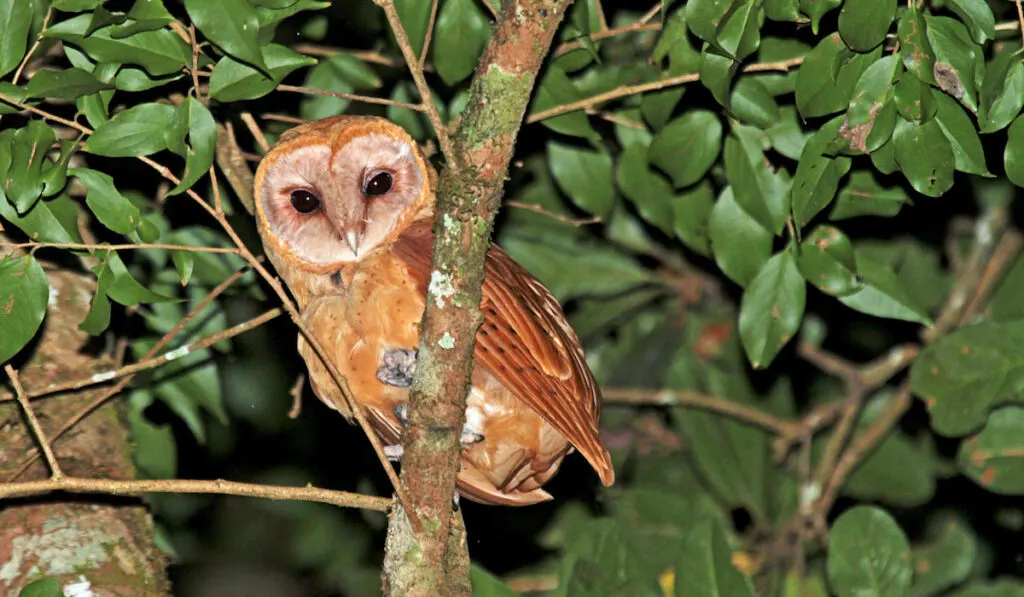
As their name states, these owls are native to Madagascar. They are also known as Soumagne’s owls and Madagascar grass owls.
You can recognize Madagascar red owls by their whitish-orange faces, dark eyes, pale gray beaks, reddish-orange bodies filled with dark spots, and dark gray feet.
Both males and females possess the same physical traits and their young usually have brighter-colored plumage.
Madagascar red owls measure 11 inches long and weigh 11.38 ounces. Their wings can extend up to 8 inches wide.
These birds are usually found in rice paddies, humid forests, dry deciduous forests, and forest edges.
These small owls feed on various small creatures including rodents, tenrecs, geckoes, insects, golden moles, and other small reptiles.
They also face a greater risk of population decline due to fragmentation and deforestation of their natural habitats.
Final Thoughts
These birds of prey play a significant role in maintaining the balance in our ecosystem. Without barn owls, it’s quite hard for humans to contain the rat population.
Moreover, these birds don’t mess with other animals or become invasive species that can bring trouble to their surroundings. Hence, there’s no reason why we should let any of these species go extinct.
Resources
- https://animaldiversity.org/accounts/Tyto_alba/
- https://www.owlpages.com/owls/species.php?s=10
- https://www.birdsinbackyards.net/species/Tyto-alba
- https://www.owlpages.com/owls/species.php?s=30
- https://www.barnowltrust.org.uk/barn-owl-facts/american-barn-owls/
- https://www.owlpages.com/owls/species.php?s=20
- https://en.wikipedia.org/wiki/Andaman_masked_owl
- https://ebird.org/species/barowl5
- https://en.wikipedia.org/wiki/Manus_masked_owl
- https://ebird.org/species/manowl2
- https://www.peregrinefund.org/explore-raptors-species/owls/ashy-faced-owl
- https://en.wikipedia.org/wiki/Ashy-faced_owl
- https://peregrinefund.org/explore-raptors-species/owls/australian-masked-owl
- https://uk.inaturalist.org/taxa/20425-Tyto-novaehollandiae
- http://www.biodiversityexplorer.info/birds/tytonidae/tyto_capensis.htm
- https://animaldiversity.org/accounts/Tyto_capensis/
- https://ebird.org/species/talowl1
- https://www.owlpages.com/owls/species.php?s=140
- https://animalia.bio/greater-sooty-owl
- https://www.owlpages.com/owls/species.php?s=240
- https://www.owlpages.com/owls/species.php?s=150
- http://datazone.birdlife.org/species/factsheet/minahasa-masked-owl-tyto-inexspectata/text
- https://en.wikipedia.org/wiki/Itombwe_owl
- http://datazone.birdlife.org/species/factsheet/congo-bay-owl-phodilus-prigoginei/text
- https://en.wikipedia.org/wiki/Red_owl
- https://animaldiversity.org/accounts/Tyto_soumagnei/
- https://www.owlpages.com/owls/species.php?s=160
- https://ebird.org/species/lemowl1
- https://animalia.bio/sulawesi-masked-owl
- https://www.oiseaux-birds.com/card-sulawesi-masked-owl.html
